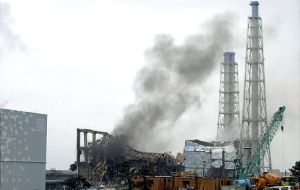MercoPress. South Atlantic News Agency
Radioactivity levels 1.250 times higher than normal in sea water at Fukushima
 The crippled Fukushima Daiichi nuclear plant
The crippled Fukushima Daiichi nuclear plant Radioactivity levels are soaring in seawater near the crippled Fukushima Daiichi plant, Japan's nuclear safety agency said, two weeks after the nuclear power plant was hit by a massive earthquake and tsunami.
Even as engineers tried to pump puddles of radioactive water from the power plant 240 km north of Tokyo, the nuclear safety agency said tests on Friday showed radioactive iodine had spiked 1,250 times higher than normal in the seawater just offshore the plant.
Officials said iodine 131 levels in seawater 30 km from the coastal nuclear complex were within acceptable limits established by regulations and the contamination posed little risk to aquatic life.
“Ocean currents will disperse radiation particles and so it will be very diluted by the time it gets consumed by fish and seaweed,” said Hidehiko Nishiyama, a senior official from Japan's Nuclear and Industrial Safety Agency.
Despite that reassurance, the disclosure may well heighten international concern over Japanese seafood exports. Several countries have already banned milk and produce from areas around the Fukushima Daiichi plant, while others have been monitoring Japanese seafood.
The prolonged efforts to prevent a catastrophic meltdown at the plant have also intensified concerns around the world about nuclear power. UN Secretary-General Ban Ki-moon said it was time to reassess the international atomic safety regime.
Radioactive water was found in buildings housing three of the six reactors at the crippled plant. On Thursday, three workers sustained burns at reactor No. 3 after being exposed to radiation levels 10,000 times higher than usually found in a reactor.
The crisis at the nuclear plant has overshadowed the massive relief and recovery effort from the magnitude 9.0 quake and the huge tsunami it triggered on March 11 that left more than 27,500 people dead or missing in northeast Japan.




Top Comments
Disclaimer & comment rules-

Read all commentsThe *Iodine in coastal water proximity indicates that there has been a water-leak from a core; perhaps not from a crack-breech but perhaps from the to/from pipework. WE NEED TO KNOW WHICH.
Mar 27th, 2011 - 02:52 pm 0The *I half-life is so short that this will be a short-term issue.
What is of much more concern is the transport of long-half-life isotopes beyond the plant boundries. For instance,
is *Caesium 137 distributed beyond the plant?
Who is doing the monitoring if it is not the IAEA? and
why is the world's International agency being kept at arms-length? Why are we allowing this with, apparently, a collusion of silence?
WE NEED ANSWERS
Commenting for this story is now closed.
If you have a Facebook account, become a fan and comment on our Facebook Page!